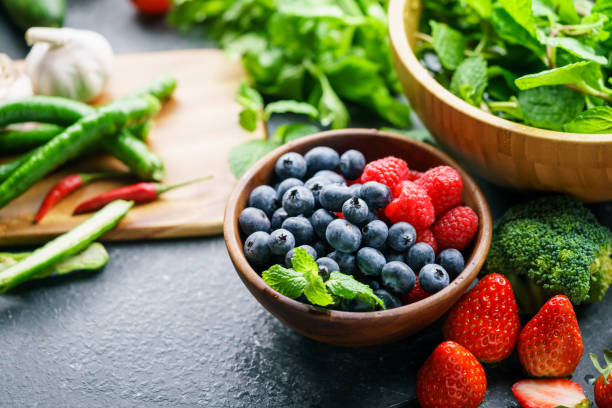In the realm of nutrition and health, the concept of eating fruits and vegetables that are in season holds significant importance. It not only ensures fresher produce but also offers a myriad of health benefits. Let’s explore the delightful world of seasonal fruits and vegetables and why they should be an integral part of your diet.
Importance of Eating Seasonal Produce
Consuming fruits and vegetables that are in season comes with numerous advantages. Firstly, seasonal produce tends to be fresher and more flavorful as it’s harvested at its peak ripeness. Secondly, it supports local farmers and reduces the carbon footprint associated with food transportation. Moreover, seasonal produce is often more affordable since it doesn’t require extensive preservation methods or long-distance shipping.
Spring Fruits and Vegetables
Spring Harvest Bounty
As the chill of winter dissipates, spring brings forth a bountiful harvest of vibrant fruits and vegetables.
Strawberries
Spring heralds the arrival of juicy strawberries, bursting with sweetness and vitamin C. These bright red berries are not only delicious but also packed with antioxidants, fiber, and essential nutrients.
Asparagus
Asparagus spears emerge during spring, offering a crisp and tender addition to your meals. Rich in folate, potassium, and vitamins A and C, asparagus promotes healthy digestion and supports overall well-being.
Peas
Fresh green peas symbolize the essence of spring, providing a delightful pop of sweetness to dishes. They are a good source of protein, fiber, and various vitamins and minerals, making them a nutritious choice for any meal.
Spinach
Spinach leaves thrive in the cool temperatures of spring, boasting a powerhouse of nutrients, including iron, calcium, and vitamins A and K. Whether enjoyed raw in salads or cooked in savory dishes, spinach contributes to strong bones and radiant skin.
Summer Fruits and Vegetables
Summer Sunshine Flavors
Summer brings an abundance of colorful fruits and vegetables, reflecting the warmth and vitality of the season.
Watermelon
Nothing epitomizes summer quite like the refreshing crunch of watermelon. This hydrating fruit is not only low in calories but also packed with vitamins A and C, promoting hydration and healthy skin.
Tomatoes
Tomatoes reach their peak sweetness and juiciness during the summer months. Bursting with lycopene, a powerful antioxidant, tomatoes support heart health and may reduce the risk of certain cancers.
Zucchini
Zucchini thrives in the summer sun, offering a versatile and nutritious addition to various dishes. Low in calories and high in fiber, zucchini promotes digestion and aids in weight management.
Bell Peppers
Colorful bell peppers add vibrancy and crunch to summer meals. Rich in vitamin C and antioxidants, bell peppers support immune function and contribute to glowing skin.
Fall Fruits and Vegetables
Autumn Abundance
As summer transitions to fall, the harvest season brings forth a rich tapestry of flavors and colors.
Apples
Crisp and sweet apples are synonymous with fall harvests. Packed with fiber and antioxidants, apples promote heart health and aid in digestion.
Pumpkins
Pumpkins take center stage during the fall months, offering more than just festive decor. Rich in beta-carotene and vitamin A, pumpkins support vision health and immune function.
Brussels Sprouts
Brussels sprouts thrive in cooler temperatures, boasting a nutty flavor and crisp texture. Loaded with fiber and vitamins K and C, Brussels sprouts contribute to bone health and collagen production.
Squash
Various types of squash, such as butternut and acorn squash, abound in the fall. These nutrient-dense vegetables are rich in vitamins, minerals, and antioxidants, supporting overall wellness.
Winter Fruits and Vegetables
Winter Warmth Nourishment
Even in the coldest months, winter offers an array of hearty and nourishing fruits and vegetables.
Citrus Fruits
Citrus fruits like oranges, grapefruits, and clementines are winter staples, brimming with vitamin C and immune-boosting properties. Their tangy sweetness adds brightness to dreary winter days.
Kale
Kale thrives in the cooler temperatures of winter, maintaining its vibrant green hue and robust flavor. Packed with vitamins A, K, and C, kale supports detoxification and provides essential nutrients during the winter months.
Cranberries
Tart and tangy cranberries are synonymous with winter festivities. Rich in antioxidants and vitamin C, cranberries promote urinary tract health and may help prevent infections.
Brussels Sprouts
Brussels sprouts make a second appearance in the winter, offering a hearty and nutritious addition to cold-weather meals.
Benefits of Eating Seasonal Produce
Incorporating seasonal fruits and vegetables into your diet offers a multitude of benefits. From supporting local agriculture to enjoying fresher and more nutritious produce, eating seasonally is a win-win for your health and the environment.
How to Incorporate Seasonal Produce into Your Diet
Embrace the diversity of seasonal produce by experimenting with new recipes and cooking methods. Visit local farmers’ markets or join a community-supported agriculture (CSA) program to access fresh, seasonal produce directly from growers. Incorporate fruits and vegetables into every meal, from smoothies and salads to soups and stir-fries, to reap the full spectrum of nutrients and flavors.
Conclusion
In conclusion, the beauty of fruits and vegetables lies not only in their diversity of flavors and colors but also in their seasonal abundance. By embracing the rhythm of nature and choosing produce that is in season, you can nourish your body, support local farmers, and savor the true essence of each season’s harvest.
